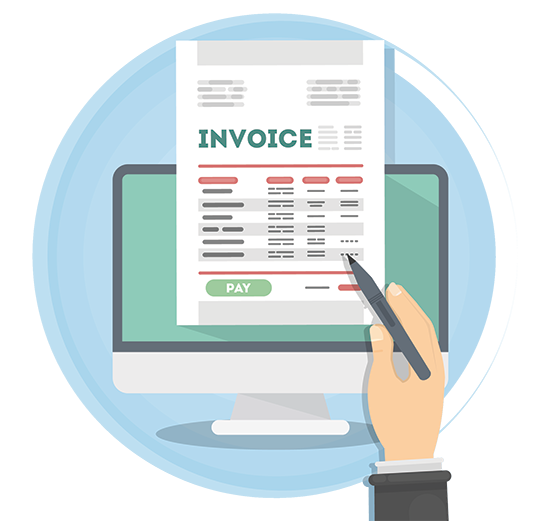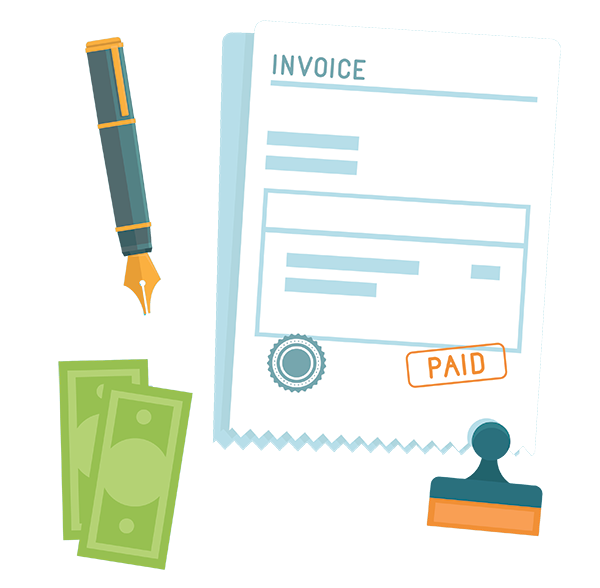Invoices play an integral role in all businesses. They ensure that money changes hands: a fair exchange for services rendered or products supplied.
But exactly what is an invoice and how can they best be used in your business?
Here we’ll introduce you to the important world of invoices, a basic guide to what they are and how to use them.
What Is an Invoice?
 “An invoice is a document that lists goods that have been supplied or services that have been done, and says how much money you owe for them.”
“An invoice is a document that lists goods that have been supplied or services that have been done, and says how much money you owe for them.”
Collins Dictionary
This definition outlines the purpose of an invoice. Put simply, they’re a way of initiating and organising requests for money.
An invoice outlines what a buyer must pay the seller after a sale has been completed, according to the seller’s payment terms. These terms inform the buyer how long they have to pay for the goods or services received.
Invoices can be used to bill for one-off projects or for recurring work and need to be generated and sent out each time a payment is due.
Traditionally, invoices were produced as a paper document, handwritten or typed, then sent in the post. Email has replaced this old-fashioned system in many businesses as they’re increasingly issued electronically.
And technology is streamlining the process still further thanks to specialist software that can generate invoices automatically and immediately.
As the age-old business operation of invoicing embraces the digital age, it’s wise to make the process as slick and simple as possible for your business.
What to Include on An Invoice
 Clearly designed and presented invoices will make life easier for everyone. Making them detailed and transparent will decrease the chances of customer quibbles and increase the chances of getting paid accurately and on time.
Clearly designed and presented invoices will make life easier for everyone. Making them detailed and transparent will decrease the chances of customer quibbles and increase the chances of getting paid accurately and on time.
A typical comprehensive invoice needs to include the following:
- A clear title indicating that it’s an invoice.
- A unique number to act as both the seller’s and buyer’s reference.
- The names and contact details of both the seller and the buyer. Email addresses are essential. It’s also wise to include a postal address in case any important documents need to be physically posted. All these details should be carefully checked for accuracy.
- The date of the invoice. This is crucial as it starts the countdown to when the invoice needs to be paid.
- The date the product was delivered or the service was supplied.
- Details of what items have been provided, including prices (per item or per hour) and quantities (of product or, for services, time).
- The total amount charged, including a breakdown of VAT and delivery charges if relevant, and any discounts already applied.
- The payment terms including how to pay, what methods are accepted, when payment is due, and details of late payment terms and early payment discounts.
- References to previous document numbers related to the sale, where relevant.
- Your business logo to raise brand awareness and establish professionalism.
- A space for a personal note if required.
How to Do Invoices
Whether you choose to issue invoices manually or via accounting software, you’ll need to have an invoice template in place, incorporating all the essential information above.
After providing a service or delivering a product, you can then prepare individual invoices. Make sure the key points are clearly presented, perhaps highlighting terms of payment in bold to make them stand out.
You can set your own payment terms here, for example a discount for early receipt of funds or immediate payment. Keep in mind the importance of cashflow and that in the UK, the law states that a customer must pay you within 30 days of receiving your invoice – unless you’ve come to a different arrangement with an individual customer.
You also have the right to charge for late payments and make a statutory demand for any not received. Whether you choose to is entirely your decision: just make sure your policies are crystal clear on all invoices.
Once completed and carefully checked for accuracy, you can send invoices out in the post, by email or via your specialist software.
Be aware that how quickly invoices are paid can depend on how you choose to issue them. As paper invoices are slower both to deliver and be processed at the other end, they’re not the most efficient option. Automated methods will typically see payments made more quickly and in some cases, even immediately.
Invoices: The Pros and Cons
 Pros
Pros
- Formalises your request for payment, prompting action from the customer. They’re unlikely to pay until they receive an invoice and it enters their system.
- Provides an opportunity to formally present payment terms.
- Shares information with the customer about the work completed or goods received. As an itemised record, it reminds them of the great service and value you’ve provided.
- Creates a record of all payment requests. This ticks HMRC’s boxes who require all businesses to keep records for up to six years and self-employed individuals to keep records of sales, income and expenses for five years. Without this paper or electronic trail, you run the risk of receiving a fine.
- Builds your brand and bolsters reputation if presented professionally and processed efficiently.
Cons
- Vague or poorly drafted invoices can be misinterpreted, jeopardising the chances of it being paid, as well as damaging a company’s reputation.
- Inaccuracies can lead to disputes, as can estimates of work completed or products provided.
- Late invoices can lead to late payments, so they should be issued as soon as possible to stress the need for swift payment.
The Importance of Getting It Right
 When researching how to do invoices, it’s wise to be aware of the tips and tricks to maximise the chances of getting paid the right amount at the right time.
When researching how to do invoices, it’s wise to be aware of the tips and tricks to maximise the chances of getting paid the right amount at the right time.
1. Choosing the Best System
If you’re new to invoicing, you’ll be weighing up your options about how best to issue and process them.
Maybe you’re considering the traditional paper approach, perhaps to save on start-up costs. But be aware this could become a false economy. Slower, prone to errors and duplication, and less efficient, this system can also position your business as tech-wary instead of tech-savvy. And with customers’ digital expectations increasing all the time, they may turn to a more forward-thinking competitor.
Instead, take a look at accounting software packages that will issue invoices automatically, send reminders and accurately keep track of the entire process. The associated apps also let you quickly send invoices from your mobile or tablet.
And some can be integrated with slick payment methods like Direct Debit for further streamlining and reliability. You’ll have a comprehensive overview of your financial status at your fingertips.
2. Aiming for 100% Accuracy
Get into the habit of checking every invoice for accuracy and you’ll be on the road to getting paid promptly by satisfied customers.
Errors such as misspellings, wrong amounts, missing VAT charges or one-digit-out bank details can lead to delays while the mistake is spotted and a new invoice is requested, raised and re-issued.
Precision while drafting the invoice and care when checking it will help to reduce confusion and frustration. The last thing you want is for a customer to dispute your invoice, damaging reputation and cashflow, and creating unnecessary admin work.
This is especially important when referencing the agreed price. If negotiations were involved to secure a discount or deal, keeping track of this and accurately reflecting it on the invoice is crucial.
Automated software can play its part here. Templates can easily be adjusted per client so bespoke details always appear, VAT can be calculated instantly, and a one-click payment button can be added so bank details don’t need to be manually inputted.
3. Being Prompt and Organised
An important element of an organised invoicing system is to issue invoices promptly. Waiting until the end of month to invoice en masse may suit your admin set-up but keep in mind that this could detrimentally affect cashflow.
Instead, sending out an invoice as soon as the work has been done or the products have been delivered will spread income out throughout the month, along with positioning your business as efficient and professional.
4. Establishing and Enforcing Clear Payment Terms
 Deciding on your payment terms is a vital part of your invoicing strategy. Credit control and cashflow will depend on it.
Deciding on your payment terms is a vital part of your invoicing strategy. Credit control and cashflow will depend on it.
As already mentioned, you have a legal right to be paid within 30 days. There’s nothing to stop you from reducing that time if it suits your business needs better.
If your business model would benefit from swifter payments, you could request that invoices are settled within seven days. If this feels a little extreme, incentivising early settlement within a 30-day period with a small percentage discount could lead to similar book-balancing results.
Also consider how you’ll deal with the inevitable late payees. And if deadlines and incentives don’t work, it’s over to you to politely and persuasively tackle the issue before taking legal steps.
What is an invoice? It’s an essential component of your business operations. Get them right and you’ll be enjoying regular payments, smooth admin and happy customers. It’s time for your business to streamline payments by using Direct Debit.






 “An invoice is a document that lists goods that have been supplied or services that have been done, and says how much money you owe for them.”
“An invoice is a document that lists goods that have been supplied or services that have been done, and says how much money you owe for them.” Pros
Pros Deciding on your payment terms is a vital part of your invoicing strategy. Credit control and cashflow will depend on it.
Deciding on your payment terms is a vital part of your invoicing strategy. Credit control and cashflow will depend on it.





